Art Generally Conveys Three Main Ideas Which Is Not One of Them?

Dance is a blazon of performing art practiced all over the world.
The performing arts are arts such as music, trip the light fantastic, and drama which are performed for an audience.[ane] It is dissimilar from visual arts, which is the use of paint, canvas or various materials to create concrete or static art objects. Performing arts include a range of disciplines which are performed in front of a alive audience, including theatre, music, and trip the light fantastic toe.
Theatre, music, dance and object manipulation, and other kinds of performances are present in all human cultures. The history of music and dance appointment to pre-celebrated times whereas circus skills date to at to the lowest degree Ancient Egypt. Many performing arts are performed professionally. Performance can be in purpose built buildings, such as theatres and opera houses, on open up air stages at festivals, on stages in tents such as circuses and on the street.
Live performances before an audience are a class of entertainment. The development of audio and video recording has allowed for private consumption of the performing arts. The performing arts frequently aims to express ane's emotions and feelings.[ii]
Performers [edit]

Performing artists in Kyoto, Japan
Artists who participate in performing arts in forepart of an audience are called performers. Examples of these include actors, comedians, dancers, magicians, circus artists, musicians, and singers. Performing arts are also supported by workers in related fields, such equally songwriting, choreography and stagecraft. Performers often arrange their advent, such as with costumes and stage makeup, stage lighting, and sound.
Types [edit]
Performing arts may include dance, music, opera, theatre and musical theatre, magic, illusion, mime, spoken word, puppetry, circus arts, professional wrestling and functioning fine art.
There is also a specialized grade of art, in which the artists perform their work alive to an audience. This is called performance art. Most functioning art also involves some form of plastic fine art, perchance in the creation of props. Dance was often referred to as a plastic art during the Modern trip the light fantastic era.[three]
Theatre [edit]
Theatre is the branch of performing arts concerned with acting out stories in front of an audience, using a combination of speech, gesture, music, dance, sound, and spectacle. Any one or more of these elements is considered performing arts. In improver to the standard narrative dialogue fashion of plays, theater takes such forms every bit plays, musicals, opera, ballet, illusion, mime, classical Indian dance, kabuki, mummers' plays, improvisational theatre, comedy, pantomime, and non-conventional or contemporary forms like postmodern theatre, postdramatic theatre, or operation art.
Dance [edit]

In the context of performing arts, trip the light fantastic more often than not refers to human being motility, typically rhythmic and to music, used every bit a form of audition amusement in a performance setting. Definitions of what constitutes dance are dependent on social, cultural, artful, artistic, and moral constraints and range from functional motility (such as folk dance) to codification, virtuoso techniques such as ballet.[4]
There is ane another modernistic course of dance that emerged in 19th- 20th century with the name of Free trip the light fantastic toe way. This form of dance was structured to create a harmonious personality which included features such as physical and spiritual freedom. Isadora Duncan was the kickoff female dancer who argued about "adult female of future" and developed novel vector of choreography using Nietzsche's idea of "supreme mind in free heed".[5]
Dance is a powerful impulse, merely the art of dance is that impulse channeled by skillful performers into something that becomes intensely expressive and that may delight spectators who feel no wish to dance themselves. These two concepts of the art of trip the light fantastic—dance every bit a powerful impulse and trip the light fantastic toe every bit a skillfully choreographed fine art practiced largely past a professional few—are the ii most important connecting ideas running through any consideration of the subject. In trip the light fantastic toe, the connectedness betwixt the 2 concepts is stronger than in some other arts, and neither can exist without the other.[4]
Choreography is the fine art of making dances, and the person who practices this fine art is called a choreographer.
Music [edit]
Music is an fine art form which combines pitch, rhythm, and dynamic to create sound. It can be performed using a variety of instruments and styles and is divided into genres such equally folk, jazz, hip hop, pop, and stone, etc. As an fine art form, music can occur in live or recorded formats, and can be planned or improvised.
Every bit music is a protean art, it easily coordinates with words for songs as concrete movements exercise in trip the light fantastic. Moreover, it has a capability of shaping homo behaviors as it impacts our emotions.[6]
History [edit]
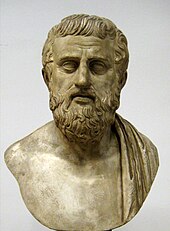
Western performing arts [edit]
Starting in the 6th century BC, the Classical period of performing art began in Greece, ushered in by the tragic poets such as Sophocles. These poets wrote plays which, in some cases, incorporated dance (see Euripides). The Hellenistic menstruation began the widespread employ of one-act.
Yet, past the 6th century Advertizing, Western performing arts had been largely ended, every bit the Dark Ages began. Between the 9th century and 14th century, performing art in the West was express to religious historical enactments and morality plays, organized by the Church in celebration of holy days and other of import events.
Renaissance [edit]
In the 15th century performing arts, forth with the arts in full general, saw a revival as the Renaissance began in Italy and spread throughout Europe plays, some of which incorporated trip the light fantastic toe, which were performed and Domenico da Piacenza credited with the kickoff use of the term ballo (in De Arte Saltandi et Choreas Ducendi) instead of danza (dance) for his baletti or balli. The term eventually became Ballet. The beginning Ballet per se is idea to be Balthasar de Beaujoyeulx's Ballet Comique de la Reine (1581).
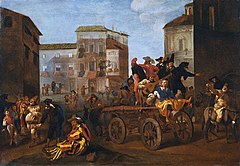
By the mid-16th century Commedia Dell'arte became popular in Europe, introducing the use of improvisation. This menstruation also introduced the Elizabethan masque, featuring music, dance and elaborate costumes as well every bit professional theatrical companies in England. William Shakespeare's plays in the late 16th century developed from this new class of professional performance.
In 1597, the first opera, Dafne was performed and throughout the 17th century, opera would speedily become the entertainment of choice for the elite in well-nigh of Europe, and somewhen for large numbers of people living in cities and towns throughout Europe.
Modern era [edit]
The introduction of the proscenium arch in Italy during the 17th century established the traditional theatre form that persists to this day. Meanwhile, in England, the Puritans forbade acting, bringing a halt to performing arts that lasted until 1660. After that, women began to appear in both French and English plays. The French introduced a formal dance instruction in the tardily 17th century.
It is also during this time that the start plays were performed in the American Colonies.
During the 18th century, the introduction of the pop opera buffa brought opera to the masses as an accessible form of functioning. Mozart's The Spousal relationship of Figaro and Don Giovanni are landmarks of the late 18th century opera.
At the turn of the 19th century, Beethoven and the Romantic movement ushered in a new era that led showtime to the spectacles of yard opera so to the musical dramas of Giuseppe Verdi and the Gesamtkunstwerk (total piece of work of fine art) of the operas of Richard Wagner leading directly to the music of the 20th century.

The 19th century was a flow of growth for the performing arts for all social classes, technical advances such as the introduction of gaslight to theatres, caricatural, minstrel dancing, and multifariousness theatre. In ballet, women make great progress in the previously male-dominated art.
Modern trip the light fantastic began in the belatedly 19th century and early 20th century in response to the restrictions of traditional ballet. The arrival of Sergei Diaghilev'southward Ballets Russes (1909–1929) revolutionized ballet and the performing arts by and large throughout the Western globe, most chiefly through Diaghilev's accent on collaboration, which brought choreographers, dancers, set designers/artists, composers and musicians together to revitalize and revolutionize ballet. It is extremely circuitous.
Konstantin Stanislavski's "Organization" revolutionized acting in the early 20th century, and continues to take a major influence on actors of stage and screen to the current twenty-four hours. Both impressionism and modern realism were introduced to the stage during this period.
With the invention of the motion picture in the late 19th century by Thomas Edison and the growth of the motion pic manufacture in Hollywood in the early 20th century, motion picture became a ascendant operation medium throughout the 20th and 21st centuries.
Rhythm and blues, a cultural phenomenon of black America, rose to prominence in the early 20th century; influencing a range of subsequently popular music styles internationally.
In the 1930s Jean Rosenthal introduced what would become mod stage lighting, changing the nature of the phase as the Broadway musical became a phenomenon in the United States.
Postwar [edit]
Mail-World War Ii performing arts were highlighted by the resurgence of both ballet and opera in the Western world.
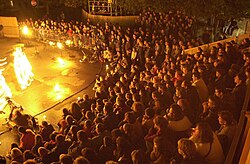
Modernistic street theatre performance in La Chaux-de-Fonds
Postmodernism in performing arts dominated the 1960s to big extent.[ citation needed ]
Eastern performing arts [edit]
Heart East [edit]
The earliest recorded theatrical effect dates back to 2000 BC with the passion plays of Ancient Egypt. The story of the god Osiris was performed annually at festivals throughout the civilisation, marking the known beginning of a long relationship between theatre and religion.
The virtually popular forms of theater in the medieval Islamic world were puppet theatre (which included hand puppets, shadow plays and marionette productions) and alive passion plays known every bit ta'ziya, where actors re-enact episodes from Muslim history. In detail, Shia Islamic plays revolved around the shaheed (martyrdom) of Ali's sons Hasan ibn Ali and Husayn ibn Ali. Live secular plays were known as akhraja, recorded in medieval adab literature, though they were less common than puppetry and ta'ziya theater.[7]

Valiollah Torabi, Iranian naqqāl (storyteller) of Shahnameh.
Iran [edit]
In Iran at that place are other forms of theatrical events such as Naghali or Naqqāli (story telling), ٰRu-Howzi, Siah-Bazi, Parde-Khani, and Mareke giri. Prior to the twentieth century, storytelling was the most recognized form of amusement, although today, some forms still remain. Ane grade, Naghali, was traditionally performed in coffeehouses where the storytellers, or Naghals (Naqqāls), only recited sections of a story at a time, thus retaining regular cliental. These stories were based on events of historical or religious importance and many referenced poetry from the Shahnameh. Often these stories were altered to bond with the atmosphere or mood of the audience.[viii]
India [edit]

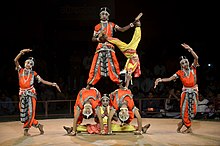
Gotikua folk trip the light fantastic is one of the well known performance performed by all boys grouping dressed in Indian ladies attire Saree
Folk theatre and dramatics tin can be traced to the religious ritualism of the Vedic peoples in the 2d millennium BC. This folk theatre of the misty past was mixed with trip the light fantastic, nutrient, ritualism, plus a depiction of events from daily life. The concluding element made it the origin of the classical theatre of later times. Many historians, notably D. D. Kosambi, Debiprasad Chattopadhyaya, Adya Rangacharaya, etc. have referred to the prevalence of ritualism amongst Indo-Aryan tribes in which some members of the tribe acted every bit if they were wild animals and some others were the hunters. Those who acted equally mammals like goats, buffaloes, reindeer, monkeys, etc. were chased by those playing the role of hunters.
Bharata Muni (fl. 5th–second century BC) was an aboriginal Indian writer best known for writing the Natya Shastra of Bharata, a theoretical treatise on Indian performing arts, including theatre, trip the light fantastic, interim, and music, which has been compared to Aristotle'due south Poetics. Bharata is often known equally the father of Indian theatrical arts. His Natya Shastra seems to be the start endeavor to develop the technique or rather art, of drama in a systematic manner. The Natya Shastra tells the states non only what is to be portrayed in a drama, but how the portrayal is to be done. Drama, as Bharata Muni says, is the imitation of men and their doings (loka-vritti). As men and their doings accept to be respected on the stage, and then drama in Sanskrit is also known past the term roopaka, which means portrayal.
The Ramayana and Mahabharata can exist considered the first recognized plays that originated in Bharat. These epics provided the inspiration to the primeval Indian dramatists and they do it even today. Indian dramatists such as Bhāsa in the second century BC wrote plays that were heavily inspired past the Ramayana and Mahabharata.
Kālidāsa in the 1st century BC, is arguably considered to be ancient Bharat'due south greatest dramatist. Three famous romantic plays written by Kālidāsa are the Mālavikāgnimitram (Mālavikā and Agnimitra), Vikramōrvaśīyam (Pertaining to Vikrama and Urvashi), and Abhijñānaśākuntala (The Recognition of Shakuntala). The concluding was inspired by a story in the Mahabharata and is the near famous. It was the starting time to be translated into English language and German. In comparing to Bhāsa, who drew heavily from the epics, Kālidāsa can be considered an original playwright.
The next bully Indian dramatist was Bhavabhuti (c. seventh century). He is said to accept written the following iii plays: Malati-Madhava, Mahaviracharita and Uttar Ramacharita. Among these three, the last two cover between them, the entire epic of Ramayana. The powerful Indian emperor Harsha (606–648) is credited with having written three plays: the comedy Ratnavali, Priyadarsika, and the Buddhist drama Nagananda. Many other dramatists followed during the Middle Ages.
There were many performing fine art forms in the southern office of India, Kerala is such a state with different such art forms like Koodiyattam, Nangyarkoothu, Kathakali, Chakyar koothu, Thirayattam and at that place were many prominent artists like Painkulam Raman Chakyar and others.
People's republic of china [edit]

At that place are references to theatrical entertainments in Prc equally early as 1500 BC during the Shang dynasty; they often involved music, clowning and acrobatic displays.
The Tang dynasty is sometimes known as "The Age of 1000 Entertainments". During this era, Emperor Xuanzong formed an acting school known as the Children of the Pear Garden to produce a form of drama that was primarily musical.
During the Han Dynasty, shadow puppetry first emerged every bit a recognized grade of theatre in Mainland china. There were two distinct forms of shadow puppetry, Cantonese southern and Pekingese northern. The ii styles were differentiated by the method of making the puppets and the positioning of the rods on the puppets, as opposed to the blazon of play performed by the puppets. Both styles generally performed plays depicting peachy gamble and fantasy, rarely was this very stylized course of theatre used for political propaganda. Cantonese shadow puppets were the larger of the 2. They were congenital using thick leather that created more substantial shadows. Symbolic color was also very prevalent; a black face represented honesty, a ruby-red one bravery. The rods used to control Cantonese puppets were attached perpendicular to the puppets' heads. Thus, they were not seen by the audition when the shadow was created. Pekingese puppets were more frail and smaller. They were created out of sparse, translucent leather unremarkably taken from the belly of a ass. They were painted with vibrant paints, thus they cast a very colorful shadow. The thin rods that controlled their movements were attached to a leather neckband at the cervix of the puppet. The rods ran parallel to the bodies of the boob then turned at a ninety degree angle to connect to the neck. While these rods were visible when the shadow was cast, they laid outside the shadow of the puppet; thus they did not interfere with the advent of the figure. The rods attached at the necks to facilitate the use of multiple heads with ane body. When the heads were not existence used, they were stored in a muslin book or material lined box. The heads were ever removed at night. This was in keeping with the old superstition that if left intact, the puppets would come to life at night. Some puppeteers went and then far every bit to shop the heads in one volume and the bodies in another, to further reduce the possibility of reanimating puppets. Shadow puppetry is said to have reached its highest signal of creative development in the 11th century earlier becoming a tool of the government.
In the Song dynasty, there were many popular plays involving acrobatics and music. These developed in the Yuan dynasty into a more sophisticated course with a iv- or five-act structure. Yuan drama spread across China and diversified into numerous regional forms, the all-time known of which is Beijing Opera, which is still popular today.
Thailand [edit]
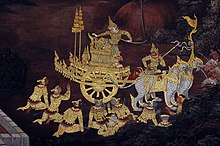
In Thailand, it has been a tradition from the Middle Ages to phase plays based on plots fatigued from Indian epics. In item, the theatrical version of Thailand's national epic Ramakien, a version of the Indian Ramayana, remains popular in Thailand even today.
Kingdom of cambodia [edit]
In Cambodia, inscriptions dating back to the sixth century AD indicates evidences of dancers at a local temple and using puppetry for religious plays. At the aboriginal capital letter Angkor Wat, stories from the Indian epics Ramayana and Mahabharata have been carved on the walls of temples and palaces. Similar reliefs are found at Borobudur in Indonesia.
Philippines [edit]
In the Philippines, the famous epic verse form Ibong Adarna, originally titled "Korido at Buhay na Pinagdaanan ng Tatlong Prinsipeng Magkakapatid na anak nina Haring Fernando at Reyna Valeriana sa Kahariang Berbania" (English language: "Corrido and Life Lived by the Three Princes, children of King Fernando and Queen Valeriana in the Kingdom of Berbania") from the 16th century was written by José de la Cruz during the Castilian era. Aside from theatrical performances, dissimilar films were produced past different film studios/ television productions. The first produced "Ang Ibong Adarna" flick was produced by LVN Pictures, the biggest film studio in the history of the Philippines.
Florante at Laura is an "awit" or a verse form consisting of 12-syllable quatrains with the full title "Pinagdaanang Buhay ni Florante at ni Laura sa Kahariang Albanya" (English language: "The History of Florante and Laura in the Kingdom of Albania") was written by Francisco Balagtas in 1838 during his imprisonment defended to his sweetheart Maria Asuncuion Rivera (nicknamed "Thou.A.R.", referenced to as "Selya"). The verse form has a special part entitled "Kay Selya" (English: "For Celia") specially dedicated for Rivera.
The Philippine'southward national hero, José Rizal who is also a novelist, created the two famous poems in the Philippines, Noli Me Tángere (Latin for "Touch me not", with an astute emphasis added on the final word in accordance with Castilian orthography) (1887) that describes perceived inequities of the Castilian Catholic friars and the ruling government and El Filibusterismo (translations: The filibusterism; The Subversive or The Subversion, as in the Locsín English translation, are also possible translations, also known by its alternative English championship The Reign of Greed) (1891). The novel's night theme departs dramatically from the previous novel's hopeful and romantic atmosphere, signifying Ibarra'due south resort to solving his country'south issues through violent means, after his previous attempt in reforming the country'southward system fabricated no effect and seemed impossible with the decadent attitude of the Spaniards toward the Filipinos. These novels were written during the colonization of the Philippines by the Spanish Empire.
All of these literary pieces were under the curriculum of the K-12 Program for Junior Loftier Schools, Ibong Adarna is under the Grade 7 Curriculum; Florante at Laura (Grade viii); Noli Me Tángere (Form nine); and El Filibusterismo (Grade 10).
Nihon [edit]


During the 14th century, there were minor companies of actors in Nihon who performed short, sometimes vulgar comedies. A manager of ane of these companies, Kan'ami (1333–1384), had a son, Zeami Motokiyo (1363–1443), who was considered i of the finest kid actors in Japan. When Kan'ami's company performed for Ashikaga Yoshimitsu (1358–1408), the shōgun of Nihon, he implored Zeami to have a court pedagogy for his arts.[9] After Zeami succeeded his father, he continued to perform and adapt his style into what is today Noh. A mixture of pantomime and vocal acrobatics, the Noh fashion of theatre has become i of Japan'south most refined forms of theatrical performance.[10]
Japan, later on a long period of civil wars and political disarray, was unified and at peace primarily due to shōgun Tokugawa Ieyasu (1600–1668). Nevertheless, alarmed at the increasing numbers of Christians inside the land due to the proselytizing efforts of Christian missionaries, he cut off contact from Nippon to Europe and Mainland china and outlawed Christianity. When peace did come up, a flourish of cultural influence and growing merchant grade demanded its ain entertainment. The first form of theatre to flourish was Ningyō jōruri (commonly referred to equally Bunraku). The founder of and main contributor to Ningyō jōruri, Chikamatsu Monzaemon (1653–1725), turned his form of theatre into a truthful fine art form. Ningyō jōruri is a highly stylized form of theatre using puppets, today nearly ane⁄3rd the size of a homo. The men who command the puppets train their unabridged lives to become master puppeteers, when they tin can then operate the puppet'south head and correct arm and cull to bear witness their faces during the operation. The other puppeteers, controlling the less important limbs of the puppet, cover themselves and their faces in a black accommodate, to imply their invisibility. The dialogue is handled past a single person, who uses varied tones of vocalism and speaking manners to simulate different characters. Chikamatsu wrote thousands of plays during his lifetime, well-nigh of which are still used today.
Kabuki began before long after Bunraku, legend has information technology past an extra named Okuni, who lived effectually the finish of the 16th century. Virtually of kabuki's material came from Noh and Bunraku, and its erratic dance-blazon movements are also an effect of Bunraku. However, kabuki is less formal and more afar than Noh, even so very pop among the Japanese public. Actors are trained in many varied things including dancing, singing, pantomime, and even acrobatics. Kabuki was first performed by young girls, and then by young boys, and by the end of the 16th century, kabuki companies consisted of all men. The men who portrayed women on stage were specifically trained to elicit the essence of a woman in their subtle movements and gestures.
History of African performing arts [edit]
| | This section needs expansion. You can assistance past adding to information technology. (February 2021) |
History of performing arts in the Americas [edit]
| | This section needs expansion. Yous can aid by adding to it. (February 2021) |
History of performing arts in Oceania [edit]
| | This section needs expansion. Y'all tin can help by adding to it. (Feb 2021) |
Oftentimes, Melanesian trip the light fantastic toe exhibits a cultural theme of masculinity where leadership and a unique skill set are important for sharing with the community.[11] These dances demonstrate the soldiery of a homo, however they tin can besides represent profitability such as encouraging conflict resolutions or healing.[12] The costumes of impersonating dancers incorporate large masks and unhuman-similar characteristics that human action to imitate mythical figures. The music can besides deed equally a vocalisation for these magical personas.[eleven]
See as well [edit]
- Amusement
- Outline of performing arts
- Performing arts pedagogy
- Performing arts presenters
- United States copyright police in the performing arts
- Pamela D, Franklin Cultural Eye for the Performing Arts
- Western farsi theatre
- Theatre of Nihon
- Western culture
References [edit]
- ^ "the-performing-arts noun - Definition, pictures, pronunciation and usage notes | Oxford Advanced Learner's Dictionary at OxfordLearnersDictionaries.com". world wide web.oxfordlearnersdictionaries.com . Retrieved xix January 2021.
- ^ Oliver, Sophie Anne (February 2010). "Trauma, Bodies, and Functioning Art: Towards an Embodied Ethics of Seeing". Continuum. 24: 119–129. doi:10.1080/10304310903362775. S2CID 145689520.
- ^ Mackrell, Judith R. (19 May 2017). "dance". Encyclopædia Britannica, Inc.
- ^ a b Mackrell, Judith. "Trip the light fantastic toe". Encyclopædia Britannica . Retrieved eleven March 2015.
- ^ Nana, Loria (30 June 2015). "Philosophical Context of Contemporary Choreographic Space". Musicology & Cultural Science. xi (i): 64–67.
- ^ Epperson, Gordan (11 April 2016). "music". Encyclopædia Britannica, Inc.
- ^ Moreh, Shmuel (1986), "Live Theater in Medieval Islam", in David Ayalon; Moshe Sharon (eds.), Studies in Islamic History and Culture, Brill Publishers, pp. 565–601, ISBN978-965-264-014-7
- ^ ""Memory of a Phoenix Plume" - ProQuest". www.proquest.com. ProQuest 209398361. Retrieved 20 September 2021.
- ^ "the-noh.com : The Words of Zeami : His Dramatic Life". www.the-noh.com . Retrieved 19 September 2021.
- ^ Bowers, Faubion (1974). Japanese theatre. Rutland, Vt.: C.E. Tuttle Co. ISBN0-8048-1131-8. OCLC 1211914.
- ^ a b "Oceanic music and dance". Encyclopedia Britannica . Retrieved two October 2021.
- ^ "Certificate unavailable - ProQuest". www.proquest.com. ProQuest 222380632. Retrieved two Oct 2021.
External links [edit]
- Bibliography of Performing Arts In The East
- European Collected Library on Performing Arts
medinasposeen1955.blogspot.com
Source: https://en.wikipedia.org/wiki/Performing_arts
0 Response to "Art Generally Conveys Three Main Ideas Which Is Not One of Them?"
Post a Comment